| |
|
|
|
|
SicilyWine.
Stories and Legends from the Kitchen to the Cellar © |
|
| |
|
|
|
"Greece has taught us the pleasure of light and harmony.
The Muslims brought us the scent of oriental gardens from the legendary Thousand and One Nights; but also the seed of fanatical exaltation, habitual deceit and rapture.
The Spaniards infected us with hyperbole and arrogance, a display of words and rites, the magnanimity of the cavalier gesture, but, with this, the taste of ash and of death." |
|
|
|
|
|
Gesualdo Bufalino |
|
|
|
|
|
PREFACE
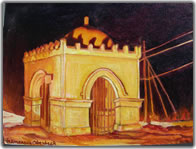 Sicily is the richest and most interesting region of Italy, according to recent statistics. In fact, more than 37% of Italian monumental and artistic wealth is found in the ancient Trinacria (term given by the ancient Greeks, depicting, according to classic iconography, the medusa with three legs, representing the triangular form of the island, and symbol of the sun). Sicily is the richest and most interesting region of Italy, according to recent statistics. In fact, more than 37% of Italian monumental and artistic wealth is found in the ancient Trinacria (term given by the ancient Greeks, depicting, according to classic iconography, the medusa with three legs, representing the triangular form of the island, and symbol of the sun).
With regard to its geographical position, Sicily is, in fact, the largest island in the center of the Mediterranean Sea, and has always been of great strategic importance for all populations that have visited it.
Sicily is a point of encounter, practically obligatory for the diverse peoples that gravitate in the area of Mare Nostrum, or “Our Sea”, a place of business exchange where different cultures have met and assimilated over the centuries, like multicolored tassels in a mosaic.
It is, shall we say, an ancient Melting Pot of people with various languages, habits, and beliefs, that have fused together in testimony of the richness that diversity provides to humanity.
The Sicilian monumental and artistic panorama emphasizes the profoundly beautiful combination of styles and patterns in each and every territory: from the Greek statues of the Satiro in Mazara del Vallo and Mothia (Trapani) and the Greco-Roman theater of Taormina to the mosaics at Piazza Armerina (Enna), and on and on through the centuries up to the present day Fiumara d’Arte of Santo Stefano and the world’s largest Open Air Museum at Gibellina (Trapani).
The great German traveler, Wolfgang Goethe (poet and writer during the XVII century) said, “To come to Italy and not visit Sicily, is not to recognize its true essence and spirit”.
This enormous and invaluable wealth, you will see, is discovered not only in the artistic-monumental aspect, but also in the richness of its enogastronomic tradition, already appreciated worldwide, though perhaps not well understood.
In Sicily, more than in other parts of the world, human history (from the Latin, Istor, or to comprehend) and legend (form Latin, Legere, or to read) are closely connected to both wine and culinary tradition.
We invite you, therefore, to read the history of Sicily by a different literary key, on that we find quite appropriate, as well as “appetizing”, and which we call
“Sicilian Wine. Stories and Legends from the Kitchen to the Cellar.” |
|
|
|
|
|
FROM THE ANCIENT GREEKS TO...SICILYWINE.COM
Agriculture, together with fishing, have been among the major activities performed by Sicilians, and their conquerors, since ancient times.
Under a sun that shines for 6-8 months per year and a fertile territory, most of volcanic origin, with varying microclimates and altitudes, from the Iblei Mountains to the Madonie and Etna, to the valleys and plateaus along the beaches, Sicily allows for all types of cultivation. It was for this 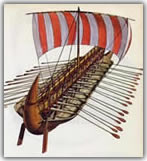 reason that the ancient Greeks decided to venture to opposite shores of the Mediterranean and establish different colonies on the island, many of which, such as Siracusa, or Syracuse once capital of Magna Grecia, or “Great Greece”, became so important that their names persist today. reason that the ancient Greeks decided to venture to opposite shores of the Mediterranean and establish different colonies on the island, many of which, such as Siracusa, or Syracuse once capital of Magna Grecia, or “Great Greece”, became so important that their names persist today.
The first indigenous inhabitants of the island, of 3000 B.C., the Sicani, and the Siculi, were dedicated to the foraging of wild fruits of the island, nourishing themselves with berries.
We do not know much about the culinary habits of the Phoenicians, originally from what we call Lebanon today, who were skilled sailors that journeyed along the entire Mediterranean, conducting business with all types of products, and founding important cities such as Palermo (which means “port city”).
While the Phoenicians were able fishermen, they were not, however, great cultivators. Despite this, we most likely owe them for the arrival of the olive and fig plants to our island.
We know that the Phoenicians surely ate boiled greens, dried fruit, and fried fish.
Remnants of their civilization are still visible at Motya, a small island near the coast of Marsala.
In 500 B.C., the Carthaginians of North Africa established their first settlements, but they were not the only ones. In fact, during nearly the exact same period on the southeastern coast of Sicily, between Syracuse, Naxos and Taormina, the Greeks arrived.
Right away, the Greeks found this land ideal for the cultivation of their favorite plants: the olive and the vine.
War broke out almost immediately between the Greeks and the Carthaginians, but lets leave that part for the historians. |
|
|
|
|
|
WINE FOR THE SPIRIT...OLIVE OIL FOR THE BODY: THE GREEK MYTHS
Homer referred to Sicilian olive oil in his Odyssey, which he based largely on this island of volcanoes and vineyards. Indeed, today we believe olive oil was the sole food product exported by the Greeks, according to its availability in Solone, around the sixth century B.C. In fact, it was here that the conservation of olives in “salamoia”, or, in salt, began, and where whole and pitted olives were packed and shipped for arrival at the tables of the gourmands of the period.
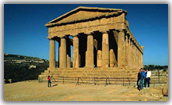 The grain here is also of the highest quality, as the characteristics of durum wheat make it optimal both for long-term preservation, and immediate use for bread-making. It is said that the rich taste of the bread was an inspirational factor in the Romans’ decision to fight for the land that later became known as the “bread basket of Rome.” The grain here is also of the highest quality, as the characteristics of durum wheat make it optimal both for long-term preservation, and immediate use for bread-making. It is said that the rich taste of the bread was an inspirational factor in the Romans’ decision to fight for the land that later became known as the “bread basket of Rome.”
Eventually, it was Sicilian grain that was used to make the durum wheat cakes that sustained many legions of seafarers and conquerors that covered the whole of the known world...
Along with the grain from Sicily, the ancient Romans exported olives, fish and cheeses in terracotta vases they called vasa salsamenteria or "delicatessen vases", made from the rich Sicilian earth. Interestingly, the salsamenteria of the time later came to be called salumeria, which is used today to mean “delicatessen.”
Unfortunately, the ancient Romans preferred the cultivation of grain to that of vines, which led to the abandonment of many vineyards and also the deforestation of large areas of land in order to make use of the wood needed for warships.
Plato (philosophical disciple of Socrates, Athens, 427-347 B.C.) write about the lifestyle and diet of the Greeks of Syracuse, which in his opinion, was overloaded with agricultural products, including cheeses, olives, onions, figs, myrtle and roasted chestnuts, often accompanied by wine. |
|
|
|
|
|
THE ARRIVAL OF THE VINES AND THE LEGEND OF DIONYSIUS
As we well know, the ancient Greeks, and then the Romans, loved myths and legends - myths and legends that were recorded by the eminent poets and philosophers of their time, and who remain fundamental to western culture today, including Socrates, Plato and Aristotle, just to name a few.
Their narratives touched upon weakness and virtue, nobility and gods, and depicted women and men who confronted wars and adventures, whether for passion or simply in search of a better understanding of the mysteries of the world and this life.
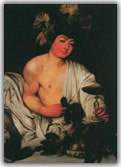 According to some of these legends, it was jealousy that precipitated the arrival of grapevines in Sicily. Zeus, the father of the gods, and always on the lookout for new love interests, fell for Armonia, a beautiful young maiden. It was his wife who, upon learning of this betrayal, went straight for the counterattack, transforming herself into the young maiden’s food, and convincing her to ask Zeus to appear to her in all of his majestic splendor with which he ruled Olympus. Armonia was already pregnant when, between claps of thunder, and flashes of lightning, Zeus appeared. The glorious sight was too much for her to bear, and the strength of her emotion caused her to give birth prematurely, shedding light on a most breathtakingly beautiful baby boy. According to some of these legends, it was jealousy that precipitated the arrival of grapevines in Sicily. Zeus, the father of the gods, and always on the lookout for new love interests, fell for Armonia, a beautiful young maiden. It was his wife who, upon learning of this betrayal, went straight for the counterattack, transforming herself into the young maiden’s food, and convincing her to ask Zeus to appear to her in all of his majestic splendor with which he ruled Olympus. Armonia was already pregnant when, between claps of thunder, and flashes of lightning, Zeus appeared. The glorious sight was too much for her to bear, and the strength of her emotion caused her to give birth prematurely, shedding light on a most breathtakingly beautiful baby boy.
At that moment, Zeus recognized the foul play, and immediately sewed the infant to one of his legs, completing the gestation period much as an incubator would, and for this reason, the child was called “Dionysus,” that is, the son of Zeus, the god of fertility, joy, and well-being. Dionysus decided to leave the Ellade and escape to Sicily, bringing a grape vine with him. As he was undertaking a long sea voyage, and needed to protect the small plant from the elements, he first placed it inside the bone of a bird, and later inside that of a lion, and since it kept growing, he finally placed it in the bone of a donkey. Thus was born the first ancient rule of drinking, and which is still worth remembering today: "A good glass of wine makes you light as a bird, another drink and you are courageous as a lion, but when you exaggerate with wine, you end up an ass!." Upon his arrival in Sicily, Dionysus planted the first vineyard at Naxos, just below Taormina, the first Greek colony. |
|
|
|
|
|
ULYSSES AND POLYPHEMUS...A LEGENDARY DRINK
The wine that came forth was strong and generous, and took well to transport, as compared to much of the must that came from other provinces, a fact well-known to Odysseus (referred to as Ulysses in Latin).
Ulysses, the principal protagonist of Homer’s Odyssey (book IX), disembarks at Sicily, where his hunger for knowledge, and food, leads him and his companions to battle with Polyphemus.
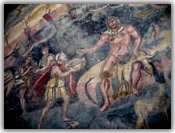 According to Greek and Roman mythology, Polyphemus was a cyclops: a giant man with just one eye. The cyclopes were blacksmiths, and helpers of Efesto or Vulcan, who most likely lived in widely dispersed caves in the vicinity of Etna Volcano. Ulysses and his men, weary from their journey at sea, came upon this territory and took refuge in one of the caves, where they feasted on all the food they could find, and rested... until the monster, and cannibal, Polyphemus, returns home. According to Greek and Roman mythology, Polyphemus was a cyclops: a giant man with just one eye. The cyclopes were blacksmiths, and helpers of Efesto or Vulcan, who most likely lived in widely dispersed caves in the vicinity of Etna Volcano. Ulysses and his men, weary from their journey at sea, came upon this territory and took refuge in one of the caves, where they feasted on all the food they could find, and rested... until the monster, and cannibal, Polyphemus, returns home.
Upon discovering the trespassers, Polyphemus imprisons them in the cave, making no secret of his plan to eat them for dinner.
Ulysses knew that the terrible monster would not be beaten by force, but by wit. Ulysses sent his men to collect the grapes of a most potent wine, probably Nerello Mascalese, which grows plentifully in those parts, and convinced Polyphemus to drink their juice, offering him “the nectar of the gods”, that is, wine.
Polyphemus, unknowing of the consequence, drank as much of the delicious nectar as they could extract. He adored this newfound pleasure, and, between mouthfuls of bread and cheese, he gulped the wine until he was quite intoxicated, and feel asleep without securing his prisoners. |
|
|
|
|
|
|
|
|
|
|
|
|
|
|
|
|
|
|
| |
1.
2.
3.
4.
5.
6.
7.
8.
9.
10.
11.
12.
13.
14.
15.
16.
17.
18.
19.
20.
21.
22. |
Preface
From the ancient Greeks to... Sicilywine.com
Wine for the spirit...olive oil for the body: the Greek Myths
The arrival of the vines and the legend of Dionysus
Ulysses and Polyphemus...a legendary drink
The oldest wine of the Mediterranean Sea: the Myth of Moscato di Siracusa
Populatum, Mamertinum, Tauromenitanum: the first DOC
How the ancient Romans and Byzantines drank wine
A.D. 500: Malvasia, the oldest dessert wine in the world, arrives
The Arabs. Zibibbo, spaghetti and cassata
Jewish Vegetables: Persian Eggplant or “Parmigiana”
The Normans: Federico II, White Wines and Agrodolce
The Second Millenium and the Advent of the Wooden Barrels
The French, the Aragonese, and the Internationalization of Sicilian Wines
De Naturali Vinorum, History and the Tavernieri
The Legend of Saint Lucy, "Arancini" and "Panelle"
The Beautifully sweet illusion of the “Martorana fruit” or “Marzipan”, and Procopio
From the Spanish to the Florios
Woodhouse. Nelson. Whitaker. The English tradition in "Sicilywine"
From Spaghetti alla Norma to Marsala "Dolce Garibaldi"
The Florio Family
SICILYWINE.COM: Where tradition meets the future...
|
|
|
|
|
|
|
|
|